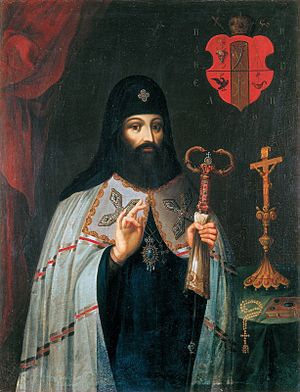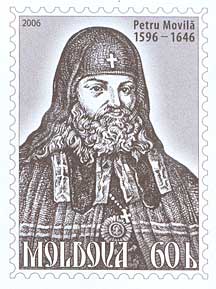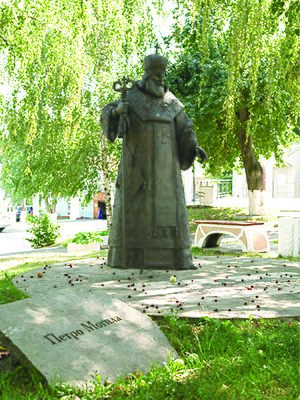Petro Mohyla facts for kids
| Petru Movilă | |
 |
|
| Religion | Christianity |
|---|---|
Quick facts for kids Personal |
|
| Born | 21 December 1596 Suceava, Moldavia |
| Died | 1 January 1647 (aged 50) Kiev, Polish–Lithuanian Commonwealth |
| Resting place | Dormition Church (Kyiv Cave Monastery) |
| Parents |
|
| Senior posting | |
| Title | Metropolitan of Kiev, Galicia and all Ruthenia, Exarch of the Ecumenical Patriarchate of Constantinople |
| Period in office | 1633–1646 |
| Consecration | 7 May 1633 in Dormition Church, Lviv |
| Predecessor | Isaia Kopynsky |
| Successor | Sylvester Kosiv |
| Religious career | |
| Previous post | Archimandrite of the Kyiv Pechersk Lavra |
| Metropolitan of Kiev, Galicia and all Ruthenia, Exarch of the Ecumenical Patriarchate of Constantinople, Holy Hierarch |
|
| Venerated in | Romanian Orthodox Church, Ukrainian Orthodox Church, Russian Orthodox Church, Polish Orthodox Church |
| Feast | 31 December 1 January; 1 October 5 October, 10 October |
Petro Mohyla (born December 21, 1596 – died January 1, 1647) was an important leader in the Eastern Orthodox Church. He served as the Metropolitan of Kiev, Galicia and all Ruthenia from 1633 to 1646. This role made him a top religious leader in a large region.
Contents
Family Background
Petro Mohyla came from the House of Movilești, a powerful family of Romanian nobles called boyars. His father, Simion Movilă, was a ruler of Moldavia. This meant Petro was born a prince. He was also related to Stephen the Great, a famous ruler.
His uncles were also important figures. Gheorghe Movilă was a Metropolitan of Moldavia, a high church position. Another uncle, Ieremia Movilă, also ruled Moldavia. Petro Mohyla's mother was Marghita Hâra.
After his father died in 1607, Petro and his mother found safety in a part of Poland. They lived in different places for several years.
His Career and Impact
In the 1620s, Petro Mohyla moved to Ukraine. At that time, Ukraine was facing many challenges. It was partly controlled by Poland. He began his spiritual journey at his home. There, he built a church.
Later, he moved to the Kyiv Pechersk Lavra in Kyiv. This was a very important center for Ukrainian culture and religion. He joined a group of scholars and church leaders. They worked to protect their culture and faith. During this time, many schools closed. Also, fewer books were printed. Many nobles changed their religion to keep their power.
In 1632, Mohyla became the bishop of Kyiv. He also became the head of the Pecherska Lavra. He used his connections with European royal families. He talked with the Polish parliament and king. He wanted them to stop unfair laws against the Orthodox Church. He also wanted to allow the use of the Church Slavonic language in schools.
Mohyla was a skilled diplomat. King Władysław IV listened to him. The king gave the Eastern Orthodox Church its rights back in the Polish–Lithuanian Commonwealth.
As a leader, Mohyla had big plans. He wanted to improve church life. He also aimed to strengthen Orthodox faith and national identity. He wanted to raise the level of education in his lands. He hoped to make it as good as in Western Europe.
Founding Schools
One of Mohyla's first steps was to open a school for young monks in 1632. Students learned in Latin. They studied theology, philosophy, and history. At the same time, Mohyla improved the printing press at the Lavra. They printed Orthodox books in Old Slavic and Latin. These books were sent across Eastern Europe.
Later that year, Mohyla combined this school with another one. He created the Mohyla Collegium. This school later became the famous Kyiv Mohyla Academy. Students came from all backgrounds. They were from noble, church, and peasant families. The school taught many subjects. These included different languages like Church Slavonic, Latin, Greek, and Polish language. They also studied philosophy, math, astronomy, and music. Because of its excellent teachers, the collegium became a top university.
In the following years, Mohyla set up more schools. He opened academies in Vinnytsia and Kremenets. He also helped the ruler of Wallachia, Matei Basarab, get a printing press. Prayer books were printed there and shared widely. He also helped start a school in Iași in Moldova.
Printing and Publications
For over 20 years, Mohyla was a leader in printing books in Ukraine. He was one of the first to print in the Ukrainian language. He and his followers helped shape the modern Russian and Ukrainian languages. Printing in Ukrainian was part of a bigger effort. It helped Ukraine keep its unique identity. This was important because of pressure from Polish and Lithuanian rulers.
Mohyla started printing sermons for people in Ukrainian. He also printed Bible texts in Church Slavonic. Scientific books were printed in Ukrainian, Polish, Greek, and Latin. Mohyla wrote several books himself. These were shared in Ukraine, Belarus, Poland, Russia, Romania, and Georgia.
One of his most important books was the first Orthodox Catholic Catechesis (1640). He wrote it because all Orthodox churches asked him to. After church leaders approved it, it became a key document for Orthodox beliefs. This book was printed 25 times in the 17th and 18th centuries.
Another important work was Trebnyk or Euchologion (1646). This book was like an encyclopedia. It organized all Ukrainian church rituals and services. Mohyla worked hard to keep Orthodox traditions pure.
In his book Anthologion, published earlier, he shared ideas about teaching. He said teachers should find different ways to teach each student. This is because every student learns differently. He believed students should think and understand, not just repeat facts. Mohyla stressed that young people should use their minds, not just emotions, to reach their goals.
In his Triodion (1631), Mohyla wrote about what a good ruler should be like. He believed a ruler should keep peace with neighbors. They should defend their lands in war. A ruler should also limit their own power, not just make laws.
His Lasting Impact
Mohyla wanted to change education by teaching Latin in schools. Some people did not like this idea. They even acted violently against teachers and schools that taught Latin. But Mohyla kept pushing for Latin. He believed it was important for students. Learning Latin would help them study at other European universities. Latin was like the common language for scholars back then.
Mohyla also cared about history. He started big projects to restore old buildings in Kyiv. One important project was the Saint Sophia Cathedral in Kyiv. People believed that as long as the cathedral stood, the city would be safe. By restoring these places, Mohyla strengthened the Ukrainian Church. He also boosted the spirits of the country. This was important when national unity was at risk.
Petro Mohyla died in 1647. In his will, he said that all his property should go to the Mohyla Collegium. He wanted all Ukrainian people to be able to read and write. For almost 200 years, this school was the only major university in the Orthodox world. It became a key center for learning and culture. Its graduates spread ideas of humanism and national pride. Many graduates taught in villages and towns. A traveler in 1655 noted that "Even villagers in Ukraine can read and write."
Because of his efforts, historians call this time the Mohyla period. Book printing grew a lot during this time. Even with political problems, Ukraine had many printing presses. They printed religious books and textbooks. This helped spread reading and writing to many people.
Veneration
Even when Metropolitan Peter Mohyla was alive, people praised him. After his death, many speeches and writings honored him. These works showed how special he was to Ukrainian church and cultural leaders.
Sainthood
Petro Mohyla is honored as a saint in several Orthodox Churches. These include the Ukrainian Orthodox Church, the Russian Orthodox Church, the Romanian Orthodox Church, and the Polish Orthodox Church. His main feast day is January 1. He is also remembered on October 5 with other sainted Metropolitans of Kyiv.
Some in the Greek Orthodox Church are more cautious about Petro Mohyla. They think he was too influenced by Roman Catholic ideas. The Orthodox Church in America also has some concerns. However, they still list him as a saint on their website.
Honors and Memorials
- The National University of Kyiv-Mohyla Academy in Kyiv is named after Petro Mohyla.
- The St. Petro Mohyla Institute in Saskatoon, Canada, is also named after him.
- In 2003, a monument to Petro Mohyla was built in Kyiv.
See also
 In Spanish: Pedro Moguila para niños
In Spanish: Pedro Moguila para niños
- Synod of Iași
- Vasilian College
Notelist





